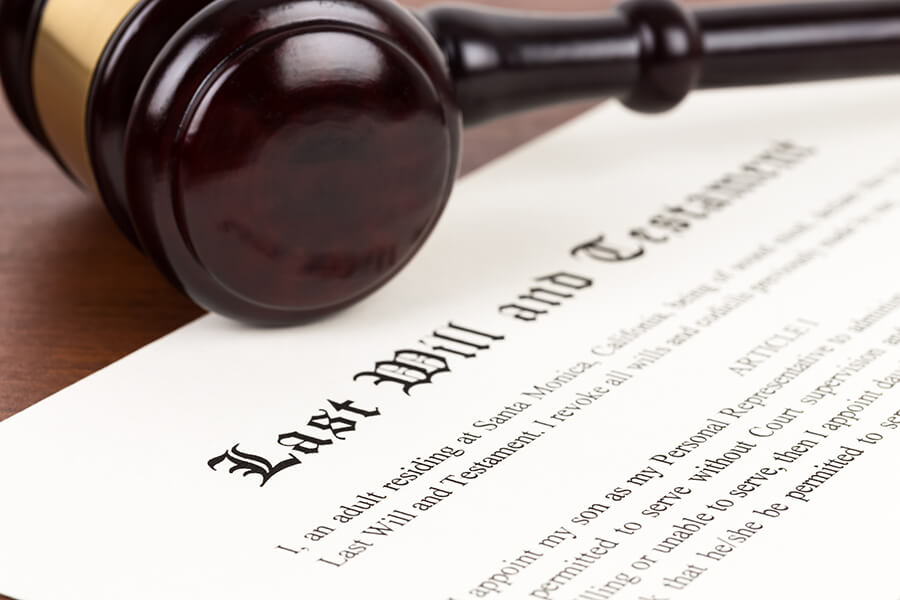California's Statutory Will Needs an Update to Keep Up with Duke

by Anne M. Rudolph and Ralph E. Hughes
I. Synopsis
California’s Statutory Will1 needs to be updated. The current California Statutory Will form became law in 1991, when Pete Wilson was governor of California and Nirvana came out with “Smells Like Teen Spirit.” In those days, any potential reformation of a will in California was governed by Estate of Barnes.2 In Estate of Barnes, California’s Supreme Court affirmed the established rule that extrinsic evidence could not be used to reform a will that was unambiguous on its face.
Not surprisingly, the California Statutory Will form enacted in 1991 reflected the rigidity of Estate of Barnes. The form repeatedly instructs the user that failure to complete the form correctly result inexorably in intestate distribution, without room for interpretation or correction. An important example of the Statutory Will form’s rigidity can be found in its provision for distribution of the residue of the testator’s estate, often the largest part of the estate. Paragraph 5 of the Statutory Will form (a portion of Probate Code section 6240) provides that if a testator fails to sign a box next to the name of the person designated to receive the residuary gift, the gift passes by intestacy.
Paragraph 5 of the form, governing distribution of the residue, is set forth below. Assume that Sally Smith, who is not familiar with filling out the boxes in legal forms, were to complete her Statutory Will form as follows:
1. Balance of My Assets. Except for the specific gifts made in paragraphs 2, 3 and 4 above, I give the balance of my assets as follows:
(Select one choice only and sign in the box after your choice. If I sign in more than one box or if I do not sign in any box, the court will distribute my assets as if I did not make a Will.)
(Emphasis added; the form itself does not highlight this language.)
a. Choice One: All to my spouse or domestic partner, registered with the California Secretary of State, if my spouse or domestic partner, registered with the California Secretary of State, survives me; otherwise to my descendants (my children and the descendants of my children) who survive me.
b. Choice Two: Nothing to my spouse or domestic partner, registered with the California Secretary of State; all to my descendants (my children and the descendants of my children) who survive me.
c. Choice Three: All to the following person if he or she survives me (Insert the name of the person.):
d. Choice Four: Equally among the following persons who survive me (Insert the names of two or more persons.):
Juanita Chavez, Sam Smith, and Priscilla Jones
In this example, Sally filled in the names of the individuals who she wished to receive the residue of her estate, but did not sign her name in the box. Under the express terms of Probate Code section 6240 (the form is itself a statute), the residue of Sally’s estate must pass by intestacy and not to the persons Sally designated. There is no ambiguity, and no room for reformation. The law requires intestate distribution, and Sally’s intent is not relevant.
When Estate of Barnes was the rule in California, this rigidity perhaps made sense. However, the California Supreme Court has decided Estate of Duke,3 which overruled Estate of Barnes and held that extrinsic evidence can be used to reform even an unambiguous will.
Under Estate of Duke, if a lawyer drafts an unambiguous but mistaken will, the will can be reformed, “to conform to the testator’s intent if clear and convincing evidence establishes that the will contains a mistake in the testator’s expression of intent at the time the will was drafted, and also establishes the testator’s actual specific intent at the time the will was drafted.”4 However, if a layperson executes an unambiguous but mistaken Statutory Will, the will cannot be reformed, and the testator’s gift goes by intestacy.
This inconsistency which works to the disadvantage of the ordinary consumer who believes that use of the Statutory Will form provides legal support for his or her estate plan, should be remedied.
II. The Problem Discussed in this Article - Mistaken Completion of the Statutory Will form - Is Real, and Is Not Small
A. The Problem Is Real
Any lawyer who has struggled to fill in the boxes on a Judicial Council form knows that it is difficult to complete a box-laden form correctly. Inadvertent mistakes are common. It is not surprising then that consumers faced with the many boxes in the Statutory Will form would have difficulty completing the form correctly.
The authors possess copies of two different statutory wills that were probated in San Diego County within the last five years, both of which featured the same mistake Sally made in the example above in completing paragraph 5 of the form. In both cases, the testator wrote the names of intended beneficiaries on the lines governing distribution of the residue and failed to sign in the box. As might be expected, in both cases, intestate heirs argued that the statutory wills were not ambiguous, and the statute required intestate distribution, to the disappointment of the named intended beneficiaries.
This particular trouble with the Statutory Will form goes back years. In 1988, when the Legislature was beginning to consider changes to the laws governing statutory wills, the Estate Planning Trust & Probate News5 published the results of a phone survey of local courts. The survey revealed that courts in Sacramento, San Diego, and Los Angeles reported problems dealing with statutory wills. Significantly, the San Diego Probate Court reported that “approximately onehalf of the property disposition clauses were not properly completed.”6 The survey reported further that, when the property disposition clauses were not completed correctly, “the estate was distributed pursuant to [intestate succession] as if the testator had made no will.”7
If we assume that San Diego testators are not uniquely mystified by the Statutory Will form, it seems very likely that improperly completed forms are being presented for probate across California, and that designated beneficiaries are losing inheritances intended by testators in favor of undesignated heirs.
B. The Problem Is Not Small
In 1998, when the Estate Planning Trust & Probate News reported that courts were having difficulty with the Statutory Will form, the form was available through the California State Bar for $1.00 per copy, with discounts for large orders.8 At that time, the California State Bar had distributed 400,000 copies of the Statutory Will form, with 30,000 having been ordered within a particular two-week period.9
Today, the Statutory Will form is readily available on the Internet. The number of forms circulating and in use is unknown, but one can assume it is quite large.
III. The Difference Between a Testator's Intent and Legislative Intent
A. Ascertaining and Enforcing the Testator’s Intent
In Estate of Duke, the court emphasized the importance of the testator’s intent, and the key role that extrinsic evidence can play in determining that intent. It remarked:
In cases in which clear and convincing evidence establishes both a mistake in the drafting of the will and the testator’s actual and specific intent at the time the will was drafted, it is plain that denying reformation would defeat the testator’s intent and result in unjust enrichment of unintended beneficiaries. Given that the paramount concern in construing a will is to determine the subjective intent of the testator . . . only significant countervailing considerations can justify a rule categorically denying reformation.10
The Duke court found no such “countervailing considerations,” and authorized use of extrinsic evidence to reform an otherwise unambiguous will.
In support of its reasoning, the Duke court noted the importance of evening the playing field to provide a method for correcting the mistakes of citizens who employ wills for their estate plans, especially those who write their own wills. The court stated:
Moreover, allowing reformation of trusts and other instruments, but never of wills, appears to favor those with the means to establish estate plans that avoid probate proceedings, and to deny a remedy with respect to the estates of individuals who effect their plans through traditional testamentary documents. Denying reformation in these circumstances seems particularly harsh with respect to individuals who write wills without the assistance of counsel, and are more likely to overlook flaws in the expression of their intent.11
The Duke court also pointed out that a preference for enforcement of the wishes of the testator over reliance on the laws of intestacy is consistent with Probate Code section 21120, which provides, “[p]reference is to be given to an interpretation of an instrument that will prevent intestacy or failure of a transfer rather than one that will result in an intestacy or failure of a transfer.”12
Estate of Duke can be seen to have relied on the following principles, all of which likewise support the notion that the Statutory Will form should be a document that can be reformed under proper circumstances:
Ascertainment and enforcement of the intent of a person who creates his or her own will; avoidance of unjust enrichment by preferring intestate heirs to beneficiaries whose status can be confirmed by evidence; and Preference to giving effect to an individual’s own wishes over the intestate rules of the Probate Code.
B. Ascertaining and Enforcing the Legislature’s Intent
Estate of Duke permits a court to modify and reform a will that a lawyer did not draft. However, Estate of Duke does not permit a court to overrule an unambiguous directive from the Legislature, and the Statutory Will includes more than one unambiguous legislative mandate in favor of intestacy. Interpretation of a person’s intent in a document evidencing a donative transfer is one thing; interpretation of the Legislature’s intent in enacting a statute is another.13
The Legislature’s instruction requiring intestate distribution when a testator fails to properly complete the box defining the distribution of the residue of his or her estate is deeply embedded in the Probate Code. Probate Code sections 6223, subdivision (b)(2)(B), 6224, 6240, and 6241, subdivision (a), all mandate intestate distribution if the Statutory Will form is not completed exactly as required on the form, regardless if the intent of the testator is clear. Section 6223, subdivision (b) (2)(B) provides: “If no property disposition clause is adopted, Section 6224 shall apply.” Section 6224 provides: “[If no property disposition clause is selected under paragraph 5] the residuary estate of a testator who signs a California statutory will shall be distributed to the testator’s heirs as if the testator did not make a will.” Section 6240 is the Statutory Will form itself, containing the intestate directive discussed above. Finally, section 6241, subdivision (a) provides: “If the testator has not made an effective disposition of the residuary estate, the executor shall distribute it to the testator’s heirs at law. . . .” Given the repetition and clarity of the legislative instruction that failure to properly complete paragraph 5 in the Statutory Will form requires intestate distribution of the residue, a trial court would be hard-pressed to ignore the legislative imperative—even in favor of the clearest evidence of a testator’s intent. Estate of Duke, itself, reveals that, faced with legislation directing intestate distribution, a trial court does not have the authority to consider extrinsic evidence of the individual testator’s intentions. The Duke court began its analysis of the court’s power in relation to the power of the Legislature, stating:
To evaluate whether there are circumstances in which this court should authorize admission of extrinsic evidence to correct a mistake in an unambiguous will, we first consider whether the Legislature’s actions in the field preclude this court from altering the rule. As explained below, a review of the development of the law in California reflects that the Legislature has codified judicial expressions of the admissibility of evidence with respect to a testator’s intent, but has not acted in a manner that restricts the authority of the court to develop the common law in this area.14
While the Probate Code sections governing the Statutory Will do not refer to the admission of evidence in interpreting a statutory will, the legislative mandate for intestate distribution is effectively the same. A court cannot admit evidence of an individual’s testamentary intent to override the Legislature’s plain requirement.
IV. Conclusion
A. The Present Situation
A key rationale in the court’s decision in Estate of Duke was to even the playing field so that the rules that permitted reformation of sophisticated trusts would be available to citizens who chose to use a simple will for their estate plan. The California Statutory Will is a simple will, but the statute precludes reformation of the disposition of the residue of the estate. The statute should be amended to permit reformation of the Statutory Will as permitted by Estate of Duke.
Under Estate of Duke “an unambiguous will may be reformed if clear and convincing evidence establishes that the will contains a mistake in the expression of the testator’s intent at the time the will was drafted and also establishes the testator’s actual specific intent at the time the will was drafted.”15 This test should be brought into the Probate Code provisions defining the terms of the Statutory Will.
B. A Proposed Statutory Fix
Any proposal to update the Probate Code provisions defining the Statutory Will faces at least the following problems: (i) the statutory preference for intestacy appears throughout the Probate Code sections governing the Statutory Will, (ii) the Statutory Will form itself is a statute, (iii) hundreds of thousands of statutory wills have been distributed, and likely executed, and (iv) it is conceivable that a clever testator or two actually intended an intestate distribution even after listing names of potential residuary distributees. Finally, the statutory solution must apply to the Statutory Will generally, and not just to the provisions in paragraph 5 of the form governing the distribution of the residue. Although this article focuses on problems with the distribution of the residue when the Statutory Will form is not completed correctly, the problems highlighted here are not limited to the residuary distribution.16
Given this backdrop, it appears that the best statutory solution is one that does not need to be incorporated into the form of the Statutory Will itself, that applies broadly to all provisions of the Statutory Will, and that applies equally to Statutory Will forms currently in circulation and to Statutory Will forms that will be circulated in the future. Finally, the statutory solution must be able to weed out the possible few wills in which the testator purposely failed to sign the box in paragraph 5, because he or she actually intended an intestate distribution. These goals could be reached by the adoption of a new Probate Code section 6244 stating:
Notwithstanding anything to the contrary in this Chapter 6 a California statutory will can be reformed if clear and convincing evidence establishes that the statutory will contains a mistake in the expression of the testator’s intent at the time the statutory will was drafted and also establishes the testator’s actual specific intent at the time the statutory will was drafted.
This statutory amendment is precise and could be adopted easily. It would apply to all statutory wills, would not require issuing a new Statutory Will form, and would incorporate the Duke test, permitting reformation under specific circumstances. The requirement of clear and convincing evidence is a test that would eliminate the small chance that a testator could have intended an intestate distribution by failing to sign the box in paragraph 5.
Anne M. Rudolph and Ralph E. Hughes – July 15, 2020
A version of this article was published in the California Trusts and Estates Quarterly, Volume 26, Issue 2, 2020, copyright Trusts and Estates Section of the California Lawyers Association, printed with permission.
1. Prob. Code, sections 6200-6243.
2. Estate of Barnes (1965) 63 Cal.2d 580.
3. Estate of Duke (2015) 61 Cal.4th 871.
4. Id. at p. 898
5. The Estate Planning Trust and Probate News was published by TEXCOM and is the predecessor to the Trusts and Estates Quarterly.
6. Ross, Sterling, The Statutory Will Revisited (1989) 10 Estate Planning, Trust & Probate News, No. 1, p. 4. (A copy of this article can be found in the legislative history of Senate Bill 271 (Kopp—1991), the bill that included the then-new form Statutory Will.)
7. Ibid.
8. Ibid.
9. Ibid.
10. Estate of Duke, supra, 61 Cal.4th at p. 890 (citations omitted).
11. Id. at p. 895.
12. Id. at p. 892.
13. Estate of Rossi (2006) 138 Cal.App.4th 1325, 1340.
14. Estate of Duke, supra, 61 Cal.4th at 879.
15. Id. at p. 876.
16. See, e.g., Probate Code, section 6233, subd. (b)(2)(B).



